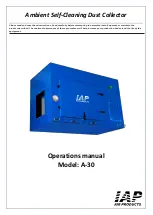
MAGNEHELIC
®
INSTALLATION
1.
Select a location free from excessive vibration
and where the ambient temperature will not
exceed 140°F Also, avoid direct sunlight which
accelerates discoloration of the clear plastic
cover. Sensing lines may be run any necessary
distance. Long tubing lengths will not affect accu-
racy but will increase response time slightly. Do
not restrict lines. If pulsating pressures or vibra-
tion cause excessive pointer oscillation, consult
the factory for ways to provide additional damp-
ing.
2.
All standard Magnehelic gages are calibrated
with the diaphragm vertical and should be used
in that position for maximum accuracy. If gages
are to be used in other than vertical position, this
should be specified on the order. Many higher
range gages will perform within tolerance in other
positions with only rezeroing. Low range Model
2000-00 and metric equivalents must be used in
the vertical position only.
3. Surface Mounting
Locate mounting holes, 120° apart on a 4-1/8"
dia. circle. Use No. 6-32 machine screws of
appropriate length.
4. Flush Mounting
Provide a 4
9
⁄
16
" dia. opening in panel. Insert gage
and secure in place with No. 6-32 machine
screws of appropriate length, with adaptors, Part
No. 360c, firmly secured in place. To mount gage
on I
1
⁄
4
"-2" pipe, order optional A-610 pipe mount-
ing kit.
5. To zero the gage after
installation
Set the indicating pointer exactly on the zero
mark, using the external zero adjust screw on the
cover at the bottom. Note that the zero check or
adjustment can only be made with the high and
low pressure taps both open to atmosphere.
Operation
Positive Pressure: Connect tubing from source
of pressure to either of the two high pressure
ports. Plug the port not used. Vent one or both
low pressure ports to atmosphere.
Negative Pressure: Connect tubing from source
of vacuum or negative pressure to either of the
two low pressure ports. Plug the port not used.
Vent one or both high pressure ports to atmos-
phere.
Differential Pressure: Connect tubing from the
greater of two pressure sources to either high
pressure port and the lower to either low pres-
sure port. Plug both unused ports.
When one side of gage is vented in a dirty, dusty
atmosphere, we suggest an A-331 Filter Vent
Plug be installed in the open port to keep inside
of gage clean.
a. For portable use or temporary installation, use
1/8" pipe thread to rubber tubing adapter and
connect to source of pressure with rubber or
Tygon tubing.
b. For permanent installation, 1/4" 0. D., or larger,
copper or aluminum tubing is recommended. See
accessory bulletin S-101 for fittings.
Page 2




































